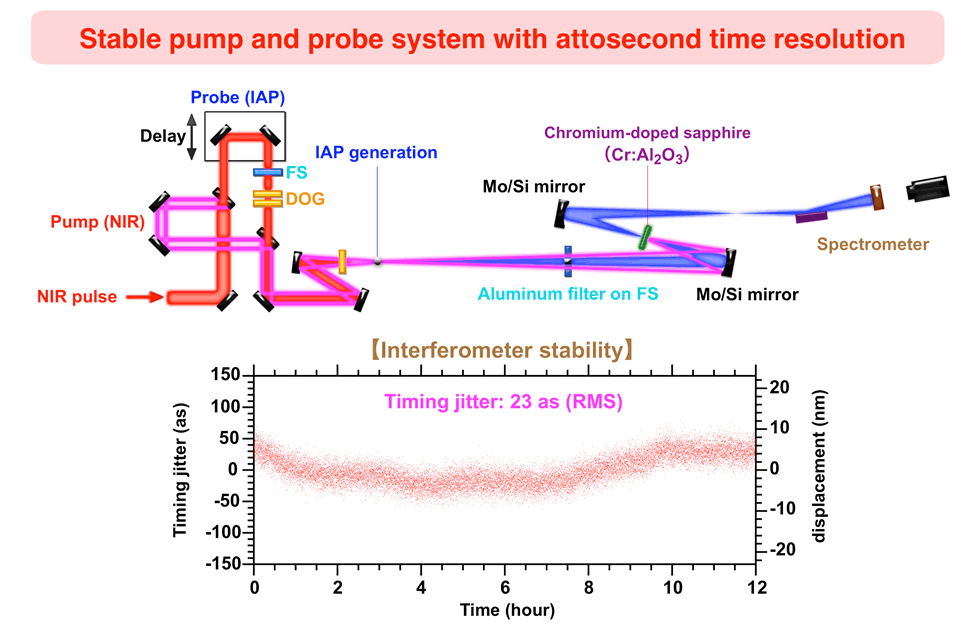Microsoft ends support for Internet Explorer on June 16, 2022.
We recommend using one of the browsers listed below.
- Microsoft Edge(Latest version)
- Mozilla Firefox(Latest version)
- Google Chrome(Latest version)
- Apple Safari(Latest version)
Please contact your browser provider for download and installation instructions.
April 17, 2018
Nippon Telegraph and Telephone Corporation
Yokohama National University
Ultrafast electron oscillation and dephasing in Cr:Al2O3 solid-state material monitored by attosecond light source
Dr. Hiroki Mashiko, Dr. Katsuya Oguri, and Dr. Hideki Gotoh of Nippon Telegraph and Telephone Corporation (NTT) (Head office, Chiyoda-ku, Tokyo, Japan; Hiroo Unoura, President and CEO) and Mr. Yuta Chisuga, Assoc. Prof. Ikufumi Katayama and Mr. Hiroyuki Masuda, and Prof. Jun Takeda of Yokohama National University (Tokiwadai, Hodogaya-ku, Yokohama, Kanagawa, Japan; Yuichi Hasebe, University President) observed petahertz (1015 of a hertz) electron oscillation using chromium-doped sapphire (Cr:Al2O3) solid-state material. The periodic electron oscillations of 667-383 attoseconds (as) (10-18 of a second) are the fastest ever been measured in direct time-dependent spectroscopy in solid-state material. The observation was performed with an extremely short isolated attosecond pulse with a robust pump-probe system. Furthermore, the individual electron dephasing times of the Cr donor-like intermediate level and the Al2O3 conduction band state were characterized. Since electron oscillation is the origin of the light-matter interaction, this study lays the essential groundwork for exploring various optical phenomena in solid-state materials, and the ultrafast time dependence will be important for study of electronic and photonic devices.
This achievement is reported in Nature Communications on April 18, 2018.
This work was supported by JSPS KAKENHI Grant No. 16H05987 and 16H02120.
1.Background
The lightwave-field induces ultrafast electric dipole oscillation *1 in the material, and the lightwave-field-induced electron oscillation is the important physical phenomenon in the fundamental light-matter interaction. However, the lightwave field in visible and ultraviolet regions can reach petahertz frequencies (1015 of a hertz) (Fig. 1), which means the oscillation periodicity can achieve attosecond (10-18 of a second) duration. To observing this ultrafast oscillation at petahertz frequencies requires extremely high temporal resolution. For example, as a camera needs a high-speed shutter to take snap shots of stop-motion, an instantaneous strobe light is necessary to observe an electron with ultrafast motion.
In a previous study, we generated an isolated attosecond pulse (IAP) *2 [H. Mashiko et al., Nature commun. 5, 5599 (2014), http://www.ntt.co.jp/news2014/1412e/141216a.html] and monitored the electron oscillation with a 1.2 PHz frequency using gallium-nitride (GaN) semiconductor [H. Mashiko et al., Nature Phys. 5, 741 (2016), http://www.ntt.co.jp/news2016/1604e/160411b.html]. The next challenges were the observation of faster electron oscillation in the chromium-doped sapphire (Cr:Al2O3) *3 insulator and the characterization of the ultrafast electron dephasing.
2.Achievements
We successfully observed the multiple near-infrared (NIR)-pulse-induced electronic dipole oscillations (periodicities of 667-383 as) in the Cr:Al2O3 solid-state material. The measurement was achieved by using the extreme short IAP (192-as duration) and a stable pump (NIR pulse) and probe (IAP) system (timing jitter of~23 as). The characterized electron oscillations are the fastest ever measured in direct time-dependent spectroscopy in solid-state material. In addition, the individual dephasing times in the Cr donor-like intermediate level and the Al2O3 CB state were revealed. Since electron oscillation is the origin of the light-matter interaction, results are important for monitoring various optical phenomena through the dielectric polarization *4. The time dependence will be useful for the study of electronic and photonic devices.
Experiments
- The probe IAP is generated by the double optical gating (DOG) technique [H. Mashiko et al., Phys. Rev. Lett. 100, 103906 (2008)]. This technique combines two optical gating methods-polarization gating and two-color gating-for the driving laser. The advantage of DOG is its ability to extract an isolated (single) attosecond pulse from attosecond pulse trains. Thus, the technique is useful for monitoring ultrafast phenomena in a variety of target materials. Here, the IAP (44-eV center photon energy with 192-as duration) in the extreme ultraviolet (XUV) region is generated from argon gas, which is used as the probe pulse of the transient absorption spectroscopy*5.
- A few-cycle femtosecond (10-15 of a second) NIR pulse excites the electron from the valance band (VB) to the Cr donor-like intermediate level and the Al2O3 conduction band (CB) state through the multi-photon process (Fig. 2). The electron transitions induce the interband polarizations and electronic dipole oscillations, which are monitored by the IAP based on the transient absorption spectroscopy (Fig. 3). The measured transient absorption trace has a variety of separations on an attosecond time scale (Fig. 4). The Fourier transformation of the delay axis in Fig. 4 shows specific energy components of 4ħω, 5ħω, 6ħω, and 7ħω(Fig. 5). In addition, the windowed Fourier transform for Fig. 5 shows the electron oscillations corresponding to the 4ħω, 5ħω, 6ħω, and 7ħω components (Fig. 6). The oscillation periodicities are 667 (4ħω), 537 (5ħω), 450 (6ħω), and 383 as (7ħω). The results indicate that the donor-like components in Cr (4ħω and 5ħω) have a relative time delay of approximately 2 fs from the CB components in Al2O3 (6ħω and 7ħω). The individual dephasing times in the donor-like and CB states could produce the relative time delay through the electron-electron scattering.
3.Technical Features
(1) Stable pump and probe system [NTT and Yokohama National University]
When the transition energy induced by the pump pulse is high, the electron oscillation periodicity is short. Since the Al2O3 insulator has a wide bandgap (the energy gap between the valence and conduction band states), the induced interband polarization has extremely short electron oscillation periodicity. Thus, a stable pump and probe system is required for the measurement. In this experiment, the system had the timing jitter of approximately 23 as at the root mean square over 12 hours. The displacement corresponds to less than ten nanometers (10-9 of a meter).
(2) Isolated attosecond pulse (IAP) generation using double optical gating (DOG) [NTT]
As mentioned above, the DOG can generate the IAP, which produces high temporal resolution for the pump and probe experiment. Since in principle, a pulse with a shorter wavelength produces shorter pulse duration, an IAP in the XUV region was used in this experiment. The IAP has a shorter wavelength than in the previous GaN experiment in the vacuum ultraviolet (VUV) region. Thus, the IAP has 192-as duration (660-as duration in previous experiment), which is suitable for monitoring faster electron motion.
4.Future Plans
The electron oscillation through dielectric polarization is the fundamental phenomenon of the light-matter interaction. This ultrafast property revealed by the direct time-domain observation will provide an ultrafast technology for the manipulating electron oscillation. The benefit of the observation is directly related the capability to control absorption, reflection, refractive index, photocurrent, photoemission, and diffraction. The study of electron motion will be important for improving the functionality and the efficiency of photonic and electronic devices in the future.







Publication information
H. Mashiko, Y. Chisuga, I. Katayama, K. Oguri, H. Masuda, J. Takeda, and H. Gotoh, "Multi-petahertz electron interference in Cr:Al2O3 solid-state material" Nature communications (2018).
Glossary
-
Dipole oscillation
A dipole is defined as the product of the magnitude of electric charges and the distance separating them. When an electron is excited by an incident light field, electrons and ions with opposite polarities create the dipole. Then, the dipole oscillation induces charge oscillation. -
Isolated attosecond pulse (IAP)
An attosecond is 1×10-18 of a second. An attosecond pulse is an optical light source with ultrashort duration, which behaves as an instantaneous strobe light. Generally, the IAP exists in the vacuum ultraviolet (VUV), extreme ultraviolet (XUV), and soft x-ray regions (approximately 3~90-nm wavelengths, 400~15 eV photon energies). The attosecond pulse is the shortest strobe light in existence. -
Chromium-doped sapphire (Cr:Al2O3)
Trigonal (rhombohedral) structured sapphire (α-Al2O3) is a typical electric insulator with a wide bandgap. It is commonly used in the manufacture of semiconductor epitaxial wafers, owing to its hardness, high thermal conductivity, and resistance to optical damage. In this experiment, the chromium (Cr) dopant produces a donor-like intermediate level for the Al2O3 host material. -
Dielectric polarization (or polarization)
Dielectric polarization occurs when a dipole moment is induced in an insulating material by an externally applied electric lightwave field. The dielectric polarization is a kind of electric, interfacial, ionic, or orientational polarization. In this experiment, the electric polarization with ultrafast dipole oscillation was used. In the electric polarization, positive and negative electric charges are shifted in within dielectric by the lightwave field. -
Transient absorption spectroscopy
In a typical experiment, both the light for excitation (pump) and the light for measuring the absorbance (probe) are produced by an ultrashort pulse. The impact of the probe pulse on the sample is recorded with photon energy (wavelength) and time to study the dynamics of the excited state. In this experiment, the NIR pulse and IAP corresponded to pump and probe pulses, respectively.
Contact information
Nippon Telegraph and Telephone Corporation
Science and Core Technology Laboratory Group, Public Relations:
science_coretech-pr-ml@hco.ntt.co.jp
Yokohama National University
General Planning Department , President's Office :
press@ynu.ac.jp
Research Initiatives and Promotion Organization:
tsumura-akiko-bv@ynu.ac.jp
Information is current as of the date of issue of the individual press release.
Please be advised that information may be outdated after that point.
NTT STORY
WEB media that thinks about the future with NTT











